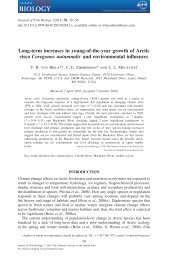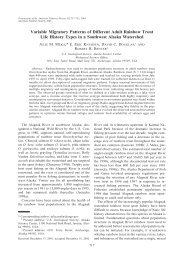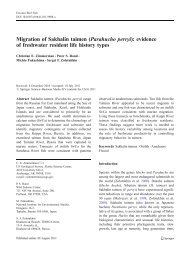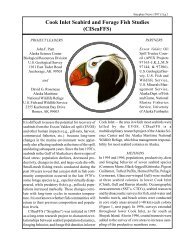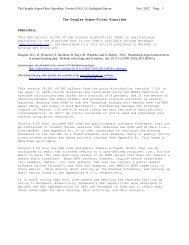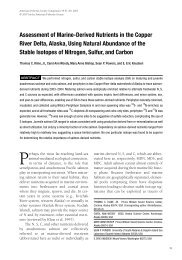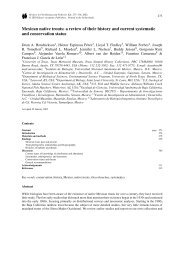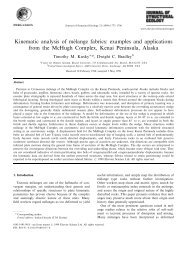Mondragon, J., S. J. Taggart, A. G. Andrews, J. K. Nielsen, and J. de ...
Mondragon, J., S. J. Taggart, A. G. Andrews, J. K. Nielsen, and J. de ...
Mondragon, J., S. J. Taggart, A. G. Andrews, J. K. Nielsen, and J. de ...
- No tags were found...
Create successful ePaper yourself
Turn your PDF publications into a flip-book with our unique Google optimized e-Paper software.
Jennifer <strong>Mondragon</strong> <strong>and</strong> others 85MethodsIn July <strong>and</strong> August 2002, the relative abundance ofTanner <strong>and</strong> red king crabs was estimated by systematicallysampling 415 stations throughout Glacier Bay. Crabs werecollected using conical, top-loading, commercial Tanner crabpots. To target juvenile <strong>and</strong> female crabs, a commercial shrimppot was attached to each of the conical Tanner crab pots witha 20 m tether. A U.S. Geological Survey research vessel, theUSGS R/V Alaskan Gyre, was used to <strong>de</strong>ploy <strong>and</strong> retrieve crabpots. Sixteen pots were set each afternoon <strong>and</strong> pulled the nextmorning after a soak time of 15 to 20 hours. As the pots wereretrieved, we counted <strong>and</strong> i<strong>de</strong>ntified all organisms to species.Carapace sizes, width for Tanner crabs, <strong>and</strong> length for kingcrabs, were measured to the nearest millimeter with verniercalipers.Results <strong>and</strong> DiscussionTanner crabs were wi<strong>de</strong>ly distributed throughout GlacierBay, <strong>and</strong> 69 percent of the pots captured at least one crab. Theonly area where crabs were consistently not captured was themain channel of the lower Bay, between Willoughby Isl<strong>and</strong><strong>and</strong> the mouth of the Bay (fig. 1). The absence of Tannercrabs in this area suggests poor habitat for this species. Theexistence of a habitat barrier could restrict movement ofTanner crabs between Glacier Bay <strong>and</strong> Icy Strait. If this is thecase, the Tanner crab population in the Bay may be <strong>de</strong>pen<strong>de</strong>nton larval flux for connectivity between the larger crabmetapopulations in southeastern Alaska.Densities of Tanner crabs were not significantly differentbetween the reserve network <strong>and</strong> the area open to commercialfishing in the central Bay (fig. 2). However, <strong>de</strong>nsities ofadults <strong>and</strong> juvenile Tanner crabs varied among reserves; theaverage catch of adults was higher in the East Arm, GeikieInlet, Scidmore-Charpentier Inlet, <strong>and</strong> the central Bay thanthe other two reserves (fig. 2). The higher <strong>de</strong>nsity of juvenilecrabs in the reserves was due to their high concentrations inWachusett Inlet <strong>and</strong> the distal ends of Scidmore-CharpentierInlet, both narrow glacial fjords (fig. 1). These areas possiblyrepresent nursery areas for Tanner crabs. If so, their inclusionin the marine reserves is particularly important for long-termeffectiveness.In contrast to the wi<strong>de</strong>spread distribution of Tanner crabs,red king crabs were highly aggregated; 73 percent of the kingcrabs were captured in seven adjacent stations near the mouthof the East Arm reserve (fig. 1). These data indicate that<strong>de</strong>sign of an effective marine reserve for red king crab willrequire <strong>de</strong>tailed sampling to <strong>de</strong>lineate patches of high <strong>de</strong>nsity.Conclusions <strong>and</strong> Management ImplicationsOur data show that reserves in close proximity havevery different abundances of king <strong>and</strong> Tanner crabs; not allreserves are created equal. This study <strong>de</strong>monstrates the valueof systematic sampling for marine reserve <strong>de</strong>sign <strong>and</strong> location.The ongoing marine reserve research in Glacier Bay willprovi<strong>de</strong> valuable information to managers, scientists, <strong>and</strong> thepublic to evaluate the utility of reserves as a management toolfor solving local, national, <strong>and</strong> global marine conservationissues.Average CPUEAdult Tanner CrabAverage CPUEJuv. Tanner Crab2015105086420p=0.065p





